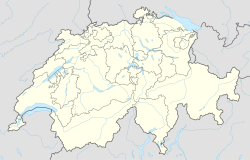Le Glèbe
| Le Glèbe | ||
|---|---|---|
| Former municipality of Switzerland | ||
 |
||
|
||
| Coordinates: 46°43′N 7°2′E / 46.717°N 7.033°ECoordinates: 46°43′N 7°2′E / 46.717°N 7.033°E | ||
| Country | Switzerland | |
| Canton | Fribourg | |
| District | Sarine | |
| Government | ||
| • Mayor | Syndic | |
| Area | ||
| • Total | 10.31 km2 (3.98 sq mi) | |
| Population (Dec 2014) | ||
| • Total | 1,246 | |
| • Density | 120/km2 (310/sq mi) | |
| Postal code | 1695 | |
| SFOS number | 2223 | |
| Surrounded by | Autigny, Farvagny, Pont-en-Ogoz, Sorens, Villorsonnens, Vuisternens-en-Ogoz | |
| Website |
commune-gibloux SFSO statistics |
|
Le Glèbe is a former municipality in the district of Sarine in the canton of Fribourg in Switzerland. It was created on 1 January 2003 by the union of Estavayer-le-Gibloux, Rueyres-Saint-Laurent, Villarlod, and Villarsel-le-Gibloux. On 1 January 2016 it merged with Corpataux-Magnedens, Farvagny, Rossens and Vuisternens-en-Ogoz to form the new municipality of Gibloux.
Le Glèbe had an area, as of 2009[update], of 10.4 square kilometers (4.0 sq mi). Of this area, 7.5 km2 (2.9 sq mi) or 72.3% is used for agricultural purposes, while 1.96 km2 (0.76 sq mi) or 18.9% is forested. Of the rest of the land, 0.85 km2 (0.33 sq mi) or 8.2% is settled (buildings or roads).
Of the built up area, housing and buildings made up 4.3% and transportation infrastructure made up 2.7%. Out of the forested land, 17.0% of the total land area is heavily forested and 1.9% is covered with orchards or small clusters of trees. Of the agricultural land, 40.5% is used for growing crops and 28.0% is pastures and 3.2% is used for alpine pastures.
Le Glèbe had a population (as of 2014[update]) of 1,246. As of 2008[update], 7.6% of the population are resident foreign nationals. Over the last 10 years (2000–2010) the population has changed at a rate of 23.5%. Migration accounted for 18.3%, while births and deaths accounted for 6.4%.
Most of the population (as of 2000[update]) speaks French (248 or 94.7%) as their first language, German is the second most common (7 or 2.7%) and Portuguese is the third (3 or 1.1%). There are 2 people who speak Italian.
...
Wikipedia



